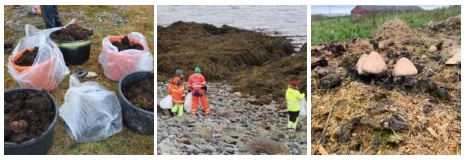Composting in the Arctic

Composting in the (post) Arctic – Exploring human-soil relations through soil work in Vardø What characterizes human-soil relations in a place where soil is a limited resource? This question is central to my doctoral research on landscape, soil and resource management in Vardø, a town situated in eastern Finnmark, Northern Norway. See my PhD-project here
Vardø used to be the only Norwegian town located in the climatic Arctic zone, but thanks to climate change the town is slowly but surely moving beyond its former ‘Arcticness’ thus becoming post-Arctic in a literal sense.1 While temperatures are rising, locals in the organization Dyrk Varanger (Grow Varanger) have built a greenhouse in collaboration with AHO to nurture both plants and community.
My interest in Grow Varanger’s wish for local organic vegetable produce centers around the question of how to approach this kind of engagement while recognizing the fact that rising temperatures are making growing possible in the first place. I lean on anthropologists Anna Tsing, Andrew Mathews and Nils Bubandt who ask: ‘[c]an we acknowledge catastrophe while also imagining possibility?’2 When supporting Grow Varanger in their efforts to produce healthy and locally grown vegetables, it becomes equally important to discuss healthy soil as the precondition for healthy vegetables. Soil is, however, limited, and expensive in Vardø. But what if the Vardø community could make their own soils?
Soil is often seen as a prerequisite for planting. However, scholars are pointing towards conceptualizing soil differently, to see soil as living and as working, and to direct more attentive and careful attitudes towards soil.3 Taking these current theoretical reflections as a point of departure, we – 15 students, a landscape professor, and a PhD scholar, all involved in the elective course Resource Atlas Varanger – traveled northwards to get our hands dirty and to explore how seaweed, animal manure, driftwood, and other local resources in Vardø could form a Hügelkultur raised bed (an old German composting technique) and eventually become soil.
The soil work in Vardø was planned in collaboration with Grow Varanger and conducted in September 2023. Ditches were dug, matter was collected, and a lot of work was put into the project. While on the one hand, it was a practical task that involved dirt, mud, and occasional rain showers, it was also an awareness project to show how directing attention towards the work of soil microbes might help strengthen human-soil relations in an almost soilless place – and hopefully provide the Vardø community with fresh and nutritious soil in the future.
The soil work was led by me, PhD scholar Ida Højlund Rasmussen, and professor Janike Kampevold Larsen from the Institute of Urbanism and Landscape at the Oslo School of Architecture and Design (AHO) in collaboration with Grow Varanger. I am deeply grateful that Grow Varanger let us experiment on their greenhouse plot of land. A special thanks goes to Erik who excavated the area, to Roy who provided our students with workwear, to Roy who found accommodation for the students, and to Gøran for letting the teachers stay in his dock house during the field trip. Last but not least, we thank the students who participated in the soil work: Andrin Alpiger, Charlotte Baumgartner, Lorenz Bischof, Lucien Bretillot, Lisa Gerlach, Luna Alexandra Gleu, Sara Haugen, Sofiia Hryshchuk, Morgane Jouneau, Tilde Helen Myrbø, Olena Perepadia, Audrey Steinmetz, Gabriel Ochoa Svendberg, Anastasia Volkova and Yian Xu. A special thanks to Andrin and Lorenz for drawing the Hügelkultur raised beds.
Literature
1. Ida Højlund Rasmussen, ‘Multispecies Stories of Vardø: An Arctic Place in Change’, Landscape Research, 2023, 5, https://doi.org/10.1080/01426397.2023.2248019.
2. Anna Lowenhaupt Tsing, Andrew S Mathews, and Nils Bubandt, ‘Patchy Anthropocene: Landscape Structure, Multispecies History, and the Retooling of Anthropology’, Current Anthropology 60, no. Supplement 20 (2019): 192, https://doi.org/10.1086/703391.
3. ‘Anthropogenic Soils – Department of Culture Studies and Oriental Languages’, 2022, https://www.hf.uio.no/ikos/english/research/projects/anthropogenic-soils/index.html; Anna Krzywoszynska, ‘Caring for Soil Life in the Anthropocene: The Role of Attentiveness in More-than-human Ethics’, Transactions of the Institute of British Geographers 44, no. 4 (2019): 661–75; Anna Krzywoszynska, ‘Nonhuman Labor and the Making of Resources: Making Soils a Resource through Microbial Labor’, Environmental Humanities 12, no. 1 (2020): 227–49; María Puig de la Bellacasa, ‘Making Time for Soil: Technoscientific Futurity and the Pace of Care’, Social Studies of Science 45, no. 5 (2015): 691–716.




